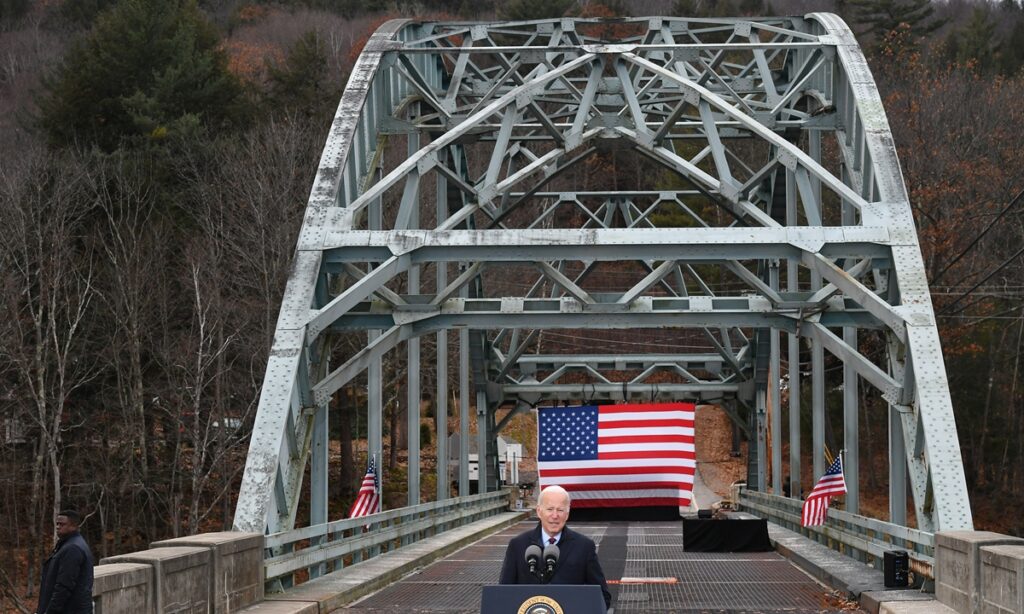Biden infrastructure bill aims to heal black areas split by highways
A rowhouse at Glenn Smith’s old Baltimore address is still standing – decades after he was forced out to make way for a grand highway project that never happened.
“It’s almost like we were robbed of our family home, where we grew up,” said the 72-year-old on a drizzly, gray morning.
Along with some 1,500 other locals, Smith had to move out of his home. He left in 1969, but he can still point to the landmarks of what once was: spots where kids played ball, a mattress factory, a pharmacy, an old movie house.
His memories are of a different kind of lost America.
“I often refer to it as a Norman Rockwell existence,” said Smith, referring to the popular US artist known for idealized portrayals of everyday life.
“Because everything was good.”
No more. Boarded-up buildings now pockmark the area – even as some newer complexes offer a glimpse of what could have been.
It is one of scores of sites in cities across the US where locals – largely black Americans in many cases – were booted out to make way for grand road projects, often with little care for the human fallout or their lost neighborhoods.
Take Smith’s Lauretta Avenue home of about 19 years, just blocks away from the “Highway to Nowhere” – a sunken, six-lane stretch of freeway that is part of a project which was never finished due to local opposition.
“For people who remain in this area, it’s like every day they see a sign of something that tore that community apart,” said Smith, who is now working to revive local development.
The freeway devastated largely black neighborhoods nearby, destroying more than 900 homes and 50 businesses, shattering families, and laying the groundwork for crime and urban blight.
Now activists like Smith hope new infrastructure projects – backed with $1 billion in federal funds – can begin to make amends for robbing black communities of their lives and livelihoods all those decades ago.
Racial reckoning
Joe Biden has vowed a racial reckoning under his presidency, driven by the Black Lives Matter movement and 2020 death of George Floyd, making racial equity a key administration goal.
One plank of policy addresses the damage wrought by all those mass highway projects in once-vibrant black communities, after a blitz of building from 1957 to 1977 displaced at least a million people.
A trillion dollar infrastructure law the Biden administration is now implementing includes at least $1 billion set aside to reconnect divided communities like Smith’s – a decent start, advocates say, toward righting past wrongs.
Biden has hit the right tone, said Baltimore City Council President Nick Mosby, whose grandmother’s home was demolished to make way for the Highway to Nowhere.
“Urban renewal initiatives have always utilized poor, black and brown communities as a canvas to develop opportunities for other communities,” he said.
The Highway to Nowhere was no exception.
“It ran through very strong, very vibrant, very connected communities and forever stole generational wealth from those communities and the descendants of folks who were [there].”
According to Smith, his father received $5,000 for the Lauretta Avenue home and moved to a house that cost $11,000.
He was given just 60 days to get out, Smith said, and struggled to find the same sort of tightly-knit community.
He was among eight children raised by a lone father after Smith’s mother died when he was 5. Only three of the siblings moved to the new home and the fallout is still felt.
Local activist Denise Johnson noted just how long it had taken government to talk seriously about making good on the past – half a century, in fact, since her father had to leave his Franklin Street home.
She said the World War II veteran revealed little emotion about his forced move, but she recalls its impact well.
“We weren’t able to see daddy as frequently,” said Johnson, the youngest of seven children.
“The landscape completely changed and the people left and you have something that was taken away but wasn’t replaced with anything that was meaningful.”
‘Historic’ moment
Baltimore is not the only place with an eye on Biden’s regeneration money, with cities from Richmond, Virginia to Syracuse, New York, hoping for a cut.
Benjamin Crowther with the Congress for the New Urbanism (CNU), a nonprofit group, said it was “historic” that the US government was finally addressing the damage done with its “Reconnecting Communities” initiative.
Crowther cited Rochester, New York, as a case in point after it spent $22 million to fill in part of its inner loop highway in 2017, reclaiming 6.5 acres (2.6 hectares) of land.
Within about two years, the city had generated private investments estimated at $229 million in development and plans for hundreds of new housing units and thousands of jobs.
Biden’s $1 billion could kick-start similar projects – but it won’t reverse things overnight, said Anthony Foxx, who was transportation secretary under former president Barack Obama.
A former mayor, Foxx grew up near the cross-section of two major freeways in an area that had faced similar disruptions – and where its black residents paid the highest price for change.
“In the wake of George Floyd’s killing and so much of what’s been on the news and on people’s minds, as we’ve seen protests across the country, people have said we need to have a real conversation,” he said.
Back in Baltimore, Pastor Rodney Hudson, whose Metropolitan United Methodist Church sits blocks from the Highway to Nowhere, lamented all the opportunities stolen by that “sunken hole.”
Building that concrete superhighway, Smith said, was like tearing the heart out a of living body.
In its wake, he hopes to revive talk of constructing the Red Line, a light rail project that would run near the desolation and could prompt new retail and residential development.
US President Joe Biden speaks on infrastructure at the NH 175 bridge over the Pemigewasset River in Woodstock, New Hampshire, the US on November 16, 2021. Photo: AFP



